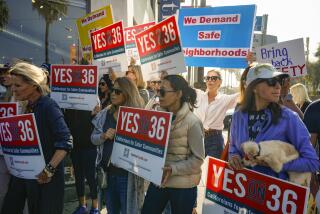Prop. 97 Would Restore Safety Program
- Share via
Nearly 22 months ago, Gov. George Deukmejian announced he would eliminate California’s job safety and health program that covered 9.5 million private-sector workers, precipitating a controversy that could end on Election Day.
Proposition 97 would compel the governor to restore funding for the program, called Cal/OSHA. To the surprise of some political observers, the California Chamber of Commerce is the only statewide business group opposing the measure on Tuesday’s ballot.
Many others, including the California Medical Assn., have joined their longtime foe, the California Labor Federation, in supporting Proposition 97. Southern California Edison Co. and Pacific Gas & Electric are backing the measure, as are the Sierra Club, the American Cancer Society, the American Industrial Hygiene Assn., the League of Women Voters and both California U.S. senators, Democrat Alan Cranston and Republican Pete Wilson, as well as Wilson’s Democratic challenger, Lt. Gov. Leo T. McCarthy.
Proposition 97 proponents have raised nearly $1.5 million and spent almost that much, according to state records, and are currently running television ads throughout the state.
According to records from the secretary of state’s office, no money has been spent by the opposition, which consists basically of Deukmejian and officials of the state Department of Industrial Relations.
However, on Tuesday, Kevin Brett, the governor’s press secretary, disclosed that Deukmejian had taped 30-second television spots and 60-second radio spots against Proposition 97. The spots are being broadcast in some markets. Brett said that stations in Los Angeles, Sacramento, San Diego and San Francisco offered to run the ads for free in an attempt to achieve a balance.
Marc Grossman, a Yes on 97 spokesman, said it was fairly typical in California campaigns for stations to offer cash-short campaigns free air time of one ad for every four that has been bought by the other side.
“It’s not usually enough to make an impact,” he said.
Proposition 97 has consistently run ahead by a 2-1 margin or better in surveys conducted by Mervin Field’s California Poll. But compared to the controversial propositions concerning insurance, AIDS and education funding, Proposition 97 is not a highly visible issue.
As a result, there is fear among the measure’s backers that that Proposition 97 could still lose because of voter frustration and alienation caused by the long ballot.
‘Plenty of Concern’
“I have plenty of concern” about the possibility that many voters will vote “no” on many propositions, simply out of frustration, said Ira Reiner, Los Angeles County district attorney, who has been the principal spokesman for Proposition 97. The lengthy ballot “is bound to have an effect, but it’s impossible to measure how much,” he added.
Deukmejian signed the ballot argument against the proposition. In addition, he has spoken out on the issue several times in recent weeks.
“The issue regarding Proposition 97 is not worker safety,” Deukmejian asserted on his Oct. 22 weekly radio broadcast.
“We all share that goal, and we have a good program at work,” he said, referring to the federal OSHA program that took over in July, 1987, after the governor vetoed funding for the state program.
“The issue voters should consider is whether they want to say no to the big government advocates and end duplication and the wasteful spending of their tax dollars,” Deukmejian added.
But Proposition 97 proponents point out that workplace inspections have declined 65% since federal OSHA took over and that workplace injuries and illnesses have increased in the past year.
Moreover, supporters of Proposition 97 point out that federal OSHA does not regulate exposure to 170 toxic substances that were controlled by Cal/OSHA. They also note that federal OSHA employs criminal prosecutions against companies that endanger their workers much less frequently than Cal/OSHA did.
Reminds Voters
If Proposition 97 passes, it will cost the taxpayers about $9 million, and the governor reminds voters of this.
Proponents, such as Reiner, say that this is a pittance in a $40-billion annual state budget.
“The state budget amounts to about $1,600 for every Californian; only 25 cents of that went to Cal/OSHA,” Reiner said. “And Proposition 97 would bring back over $11 million annually in federal funds that Cal/OSHA used to receive.”
The governor demonstrated hostility toward Cal/OSHA almost as soon as he took office in 1983. By December of that year, the agency’s staff had been depleted by 20% through a combination of budget cuts and a freeze on state employment. Democratic legislators and Reiner blasted the governor for the actions.
In March, 1984, it was revealed at a legislative hearing that some serious worker injuries were not being investigated by Cal/OSHA because of inadequate staff. Some of the staff cuts were restored over the next year and a half. But Los Angeles Mayor Tom Bradley attacked Deukmejian in the 1986 gubernatorial campaign for failing to enforce worker safety laws.
When Deukmejian announced in January, 1987, that he planned to abolish the state’s private-sector worker safety program, some saw it as a logical progression. The governor and his aides say the decision was made purely as an attempt to cut the state budget.
Businesses Not Consulted
Representatives of a variety of business organizations, including the California Manufacturers Assn., which is neutral on Proposition 97, said they were not consulted by the governor’s office on his 1987 decision. No major business group has publicly said it urged the governor to take the action.
Some business spokesmen said the governor may have misread the response of labor and other groups.
“I suspect he (Deukmejian) felt there was support out there,” one business lobbyist said.
His staff “never confirmed” that the support existed, the source said, “and for whatever reason, the Administration has hung tough.”
Kirk West, president of the Chamber of Commerce, said, “The issue is not one we initiated.”
West said the organization came out against Proposition 97 because it believed that the governor’s position was sound and that the organization’s 60 directors had been unanimous on the issue.
Ken Todd, a spokesman for the California Medical Assn., which is on the opposite side of the issue, said it has not been a close call for his group either.
“We feel Cal/OSHA was doing an outstanding job, and we feel it should be reconstituted,” Todd said. “It was by all objective standards effective in preventing worker injuries, as well as (serving as) a preventive health measure.”
The state has retained responsibility for protecting the health and safety of California’s state and local government workers.
Earlier this year, a state appeals court ruled that Deukmejian’s action in vetoing Cal/OSHA funding was illegal. The governor’s appeal of the case is pending before the state Supreme Court. If Proposition 97 passes, the case will become moot; if the measure is defeated, the case will proceed.
More to Read
Get the L.A. Times Politics newsletter
Deeply reported insights into legislation, politics and policy from Sacramento, Washington and beyond. In your inbox three times per week.
You may occasionally receive promotional content from the Los Angeles Times.










